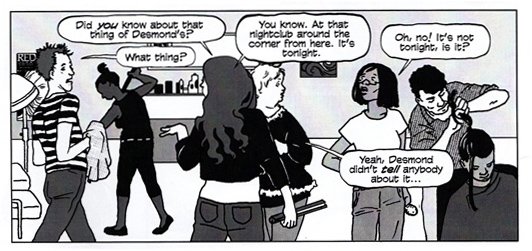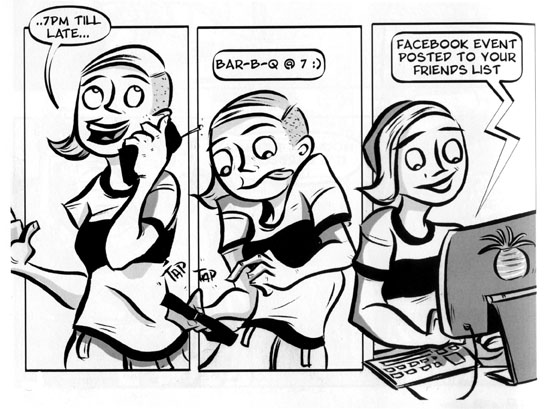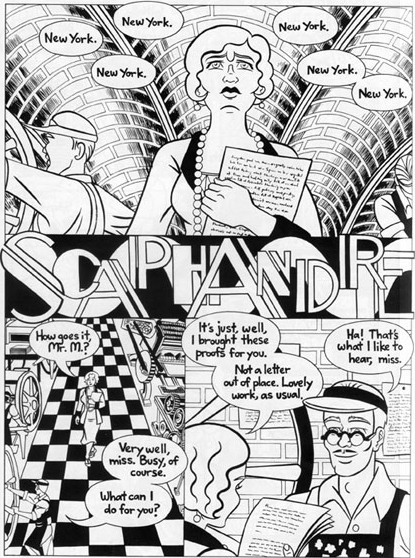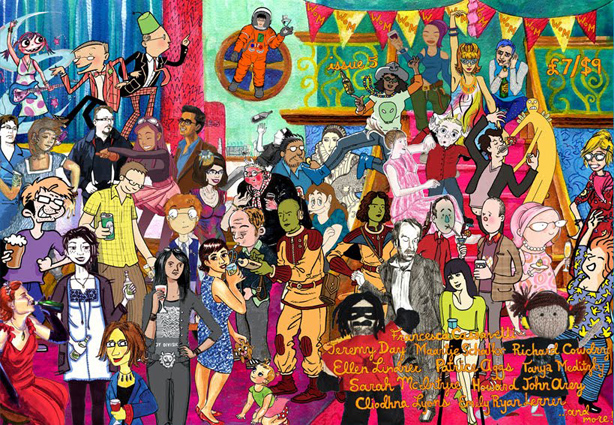Whores of Mensa 5
Reviewed by Gavin Burrows 26-Jan-11
The previous four issues of this small press comic seemed to emanate from a gang. I could imagine members Mardou, Jeremy Day (formerly Jeremy Dennis) and Ellen Linder (replacing Rachel Sweet after the first issue) as a kind of convention-cruising girl gang, strutting between the trestle tables, WoM logo stitched matchingly to the back of their leather jackets.
The previous four issues of this small press comic seemed to emanate from a gang. I could imagine members Mardou, Jeremy Day (formerly Jeremy Dennis) and Ellen Linder (replacing Rachel Sweet after the first issue) as a kind of convention-cruising girl gang, strutting between the trestle tables, WoM logo stitched matchingly to the back of their leather jackets.
Yet this time round the once-select band have thrown a party and everyone’s invited! No less than forty-three cartoonists show up to crowd into the happening scene on the wraparound cover. With everyone drawing themselves in their own idiosyncratic style, it makes you wish comics socials could actually look that way! Fourteen then make it to the more selective event between the covers, a mixture of old friends and new…
 Patrice Aggs’ ‘Grace Jones Has Left the Building’ (right) is set in a busy hairdresser’s salon, a hubbub of overlapping gossip nestling inside a tangled web of rumour. (It’s appealing that we never find the truth to any of these tales, they’re just there to set the characters off.) Our protagonist remains taciturn, like the eye of a storm.
Patrice Aggs’ ‘Grace Jones Has Left the Building’ (right) is set in a busy hairdresser’s salon, a hubbub of overlapping gossip nestling inside a tangled web of rumour. (It’s appealing that we never find the truth to any of these tales, they’re just there to set the characters off.) Our protagonist remains taciturn, like the eye of a storm.
As conversations criss-cross, Aggs pulls off something which could only be done in comics. In the immediate real-time world of film or theatre, dialogue couldn’t overlap as it would in real life, or else it would collapse into cacophony in the viewer’s ear. But here we accept the convention that events within each panel happen simultaneously, yet at the same time have the leisure to unpick and separate all the strands.
 It can be a feature of small press strips, dashed off between day jobs, that they become exercises in style rather than substance. This bothers some more than others. Cliodna Lyon’s ‘Partwhy?’ (right), for example, takes eight pages to tell what is admittedly a simple gag. But you’re better off not focusing on the gag but luxuriating in the bold excess of her style, her deftly characterised figures, her lively and confident brush strokes, her creative use of white space. You could say a similar thing about Emily Ryan Lerner’s deft balancing of black and white design elements in ‘New Year’s Eve 2002’.
It can be a feature of small press strips, dashed off between day jobs, that they become exercises in style rather than substance. This bothers some more than others. Cliodna Lyon’s ‘Partwhy?’ (right), for example, takes eight pages to tell what is admittedly a simple gag. But you’re better off not focusing on the gag but luxuriating in the bold excess of her style, her deftly characterised figures, her lively and confident brush strokes, her creative use of white space. You could say a similar thing about Emily Ryan Lerner’s deft balancing of black and white design elements in ‘New Year’s Eve 2002’.
But perhaps most pertinent of all would be Maartje Schalkx’s ‘Found’. In a vivid visual device, she eschews panels to show her characters cross the streets of an actual map, the reader’s eye following them down roads and across pages, following them even as they double back on themselves. It’s an audacious matching of the physical space of the comics page with other common depictions of space. The ostensible narrative might be the slightest of anecdotes, but the result is like a modern jazz combo playing with an old standard, using its simple familiarity as a base to work from.
 Those keener on more traditional storylines may take to Ellen Linder’s ‘Scaphandre’ (right). The master of period, and author of the Sixties-set novel ‘Undertow’, Linder now turns to the Twenties. It’s notable that this time the party is not the centre of the piece, but just one scene in an ongoing narrative. It seems unclear, however, whether this is the first part of a longer storyline or not. It looks like it’s going places so far only hinted at, so let’s hope for the second.
Those keener on more traditional storylines may take to Ellen Linder’s ‘Scaphandre’ (right). The master of period, and author of the Sixties-set novel ‘Undertow’, Linder now turns to the Twenties. It’s notable that this time the party is not the centre of the piece, but just one scene in an ongoing narrative. It seems unclear, however, whether this is the first part of a longer storyline or not. It looks like it’s going places so far only hinted at, so let’s hope for the second.
Overall, this comic pulls of the trick most required of any party host – making everyone mingle and have fun with apparent effortlessness. With such a variety of styles and approaches, don’t expect to like everything herein, anymore than you’d find every single party guest to be telling tales to your liking. Find the zones you like, and stick to them…
One word of warning, the ‘adults only’ “sachet of salaciousness” kept inside a sealed brown envelope isn’t really the equivalent of a party’s make-out room. You suspect the “catch-all solution to late-arriving submissions” might be a more accurate term…
Tags: Cliodna Lyon, Ellen Linder, Emily Ryan Lerner, Jeremy Day, Maartje Schalkx, Patrice Aggs, small press